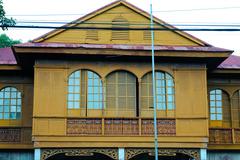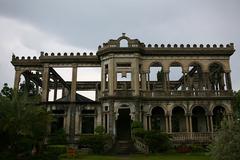West Negros University Visiting Guide: Hours, Tickets, History, and Travel Tips in Bacolod
Date: 04/07/2025
Introduction: Discover West Negros University and Its Monumental Legacy
West Negros University (WNU), now known as STI West Negros University (STIWNU), is a cornerstone of education and culture in Bacolod City, Negros Occidental. Established in 1948 by visionary educators, WNU has grown from its humble beginnings into a modern university, recognized for academic excellence and community development. Central to its campus is the STI West Negros University Monument, a landmark that honors the institution’s enduring influence on the region’s educational and social landscape.
This comprehensive guide equips prospective visitors, students, and tourists with everything needed to plan a meaningful visit to WNU and its monument. Details on visiting hours, accessibility, guided tours, campus highlights, and nearby attractions such as San Sebastian Cathedral and the Negros Museum are included. Whether you’re interested in exploring the university’s blend of heritage and innovation, attending cultural events, or immersing yourself in Bacolod’s rich history, this guide is your essential resource. For official details, consult the STI West Negros University website and Alumni.net.
Table of Contents
- Introduction
- History and Cultural Significance
- Visiting Information
- Campus and Monument Highlights
- Nearby Attractions in Bacolod City
- Travel Tips and Recommendations
- Frequently Asked Questions (FAQs)
- Plan Your Visit and Resources
History and Cultural Significance
Founding and Evolution
West Negros University was founded in 1948 by Luciana Aritao, Teresa Padilla, and Rosario Remitio, starting as West Negros College. Over decades, it grew into a university, attaining full university status in 2008. In recent years, the institution became part of the STI Education System, now officially named STI West Negros University. Throughout its evolution, WNU has remained a beacon of Christian education, academic achievement, and community service in Western Visayas, shaping generations of leaders (Alumni.net).
The STI West Negros University Monument
Strategically located within the campus, the STI West Negros University Monument symbolizes the institution’s rich heritage and ongoing contribution to educational advancement in Negros Occidental. It stands as a tribute to the university’s transformative journey and the countless scholars nurtured within its halls.
Visiting Information
Hours and Admission
- Visiting Hours: Daily, 8:00 AM – 6:00 PM for the monument; campus generally accessible Monday to Saturday, 8:00 AM – 5:00 PM.
- Admission: Free. Both locals and tourists are welcome.
- Special Events: Some academic or cultural events may have separate ticketing; see the university’s event calendar or Digicast Negros.
Guided Tours
Guided tours are available upon request through the university’s visitor center or public relations office. It’s advisable to book in advance, especially for groups, by contacting the university via its official website.
Accessibility and Facilities
- Wheelchair Access: The monument and most newer campus buildings, including the recently inaugurated School of Basic Education (SBE), are equipped with ramps and elevators.
- Amenities: Restrooms, seating areas, and a café are located near the monument. Informational plaques provide historical context in both English and Filipino.
- Parking: Ample parking is available for visitors.
Campus and Monument Highlights
- Historical and Modern Architecture: Explore structures reflecting the blend of heritage and contemporary design.
- School of Basic Education (SBE): Opened in 2024, this building offers modern classrooms, laboratories, and a spacious library (Digicast Negros).
- University Galleries and Libraries: Home to cultural exhibits and academic resources.
- Sports Facilities: Venues for local sports and youth activities.
- Landscaped Grounds: Ideal for photography and relaxation.
- Monument Design: The monument’s layout and landscaping offer excellent photo opportunities, especially during sunrise or sunset.
Nearby Attractions in Bacolod City
Enhance your visit by exploring these nearby sites:
- San Sebastian Cathedral: A neo-Gothic church known for its stained glass and role in local culture.
- Negros Museum: Showcases the region’s art, history, and cultural heritage.
- Rizal Street: Famous for heritage architecture and vibrant local life.
- Public Plazas and Food Markets: Enjoy Bacolod’s culinary specialties, including chicken inasal.
Travel Tips and Recommendations
- Getting There: The campus is easily accessible by jeepneys, taxis, and ride-hailing services. The Bacolod-Silay Airport is 30–40 minutes away by car.
- Best Times to Visit: Early mornings or late afternoons for pleasant weather and optimal lighting.
- Visitor Etiquette: Modest attire is recommended when entering university buildings and cultural sites.
- Stay Updated: Check the university’s and city’s tourism websites for event schedules and visitor advisories.
Frequently Asked Questions (FAQs)
Q: Is there an entrance fee to visit the monument or campus?
A: No, visiting is free of charge.
Q: Can I book a guided tour?
A: Yes, tours are available by prior arrangement through the university.
Q: Is the campus wheelchair accessible?
A: Yes, most areas are accessible with ramps and elevators.
Q: Are there facilities for visitors?
A: Yes, restrooms, seating, and a café are available.
Q: Are events open to the public?
A: Many events are public; check the university calendar for details.
Plan Your Visit
To maximize your experience:
- Download the Audiala app for guided tours and Bacolod travel resources.
- Follow STI West Negros University and Bacolod City tourism offices on social media for updates.
- Combine your WNU visit with a tour of San Sebastian Cathedral and the Negros Museum for a full immersion in Bacolod’s heritage.
For maps, event schedules, and updated visitor information, refer to the Bacolod City Tourism Office.
San Sebastian Cathedral: Bacolod’s Iconic Religious Monument
Overview
San Sebastian Cathedral, at the heart of Bacolod City, is an architectural and cultural treasure. Established in 1876, this neo-Gothic church is a focal point for local religious life, festivals, and community events.
Highlights
- Architecture: Spanish colonial influences, intricate stained glass, and a prominent bell tower.
- Cultural Role: Venue for MassKara Festival activities, weddings, and community gatherings.
- Visiting Hours: Daily, 6:00 AM – 7:00 PM; no entrance fee, but donations appreciated.
- Accessibility: Ramps and seating areas are available; easily reached by local transport.
Nearby Attractions
- Negros Museum: Art, history, and local culture.
- Bacolod Public Plaza: Landscaped gardens and event space.
- San Sebastian Park: Green space for relaxation.
- Local Markets: Sample Bacolod’s culinary favorites.
Visitor Tips
- Wear modest attire.
- Visit early or late for a peaceful atmosphere and good photography conditions.
- Photography is permitted, but avoid flash during services.
For more on San Sebastian Cathedral, see the Bacolod City Tourism Office.
Summary and Visitor Recommendations
West Negros University and the STI West Negros University Monument, alongside Bacolod’s other historical sites like San Sebastian Cathedral and the Negros Museum, offer visitors a rich tapestry of culture, education, and community spirit. The university’s blend of tradition and progress is evident in its historical buildings, modern facilities, and landmark monument. Free admission, accessible amenities, and guided tours make it an inviting destination for all.
For a holistic Bacolod experience, complement your campus visit with city landmarks, local events, and culinary discoveries. Stay connected with the latest schedules and updates through official channels and the Audiala app.
References and Further Reading
- STI West Negros University official website
- West Negros University on Alumni.net
- Digicast Negros - SBE Building Inauguration
- Bacolod City Tourism Office
- Klook - Bacolod Tourism Guide
- Pinoy Adventurista - Bacolod Itinerary

